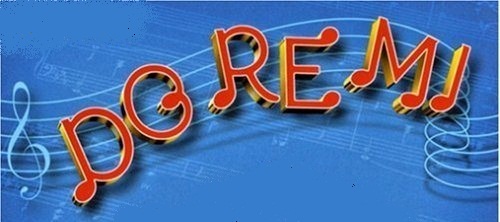Do Re Mi
Musical (1960)

The show opened on Broadway at the St. James Theatre on December 26, 1960, transferred to the 54th Street Theatre on December 25, 1961 and closed on January 13, 1962 for a total of 400 performances. Scenic design was by Boris Aronson, costume design by Irene Sharaff with assistance from Florence Klotz, and choreography was by Marc Breaux and Dee Dee Wood.
The London West End production opened at the Prince of Wales Theatre on October 12, 1961 and ran for 169 performances. It starred Max Bygraves, Maggie Fitzgibbon, Steve Arlen and Jan Waters.
Encores! At New York's City Center presented a concert version in 1999, starring Nathan Lane, Brian Stokes Mitchell, Heather Headley and Randy Graff.
The 42nd Street Moon theatre company, San Francisco, California production ran in August 2001.
Hubie Cram is "a loser endlessly scheming to win big." His long-suffering patient wife Kay urges him to "Take a Job," while he plots. He finds three pals, Fatso O'Rear, Brains Berman and Skin Demopoulos, and they scheme to enter the juke-box business ("It's Legitimate"). Soon they have 300 juke-boxes, which they plan on selling to John Henry Wheeler, a record producer. Hubie discovers a naive singer, Tilda Mullen, and they plan their future ("Ambition"). At a fancy nightclub Hubie explains, and demonstrates, gangster's behavior that he learned from watching the Late Late Show. Kay compares her abandoned comfortable existence with the insecurity of life with Hubie ("Adventure"). Tilda and Wheeler fall in love ("Make Someone Happy"). In the end Hubie realizes that he has nothing except a wonderful marriage.
The musical was notable for its elaborate scenic design by Boris Aronson, who conceived the set as an enormous pop art jukebox and used extremely novel forms like collage in his design. The curtain of juke boxes "evoked a cathedral's stained glass effect."[1] In a scene in a night club, the tables had drawn figures instead of actors, and the actors would talk with these drawings.[2] And in the "Fireworks" number, black light is used to reveal shooting stars and roman candles as Tilda and John's love affair explodes in song.
Act I
"Waiting, Waiting" – Kay Cram
"All You Need Is a Quarter" – The Swingers
"Take a Job" – Hubie and Kay Cram
"It's Legitimate" – Hubie, Fatso O'Rear, Brains Berman, Skin Demopoulos and the Loaders
"I Know About Love" – John Henry Wheeler
"The Auditions" – Marsha, Lou and Gretchen
"Cry Like the Wind" – Tilda Mullen
"Ambition" – Hubie and Tilda Mullen
"Success" – The Tilda Mullen Fans, Tilda Mullen, Hubie, Fatso O'Rear, Brains Berman and Skin Demopoulos
"Fireworks" – Tilda Mullen and John Henry Wheeler
"What's New at the Zoo" – Tilda Mullen and Animal Girls
"Asking for You" – John Henry Wheeler
"The Late, Late Show" – Hubie
Act II
"Adventure" – Hubie and Kay Cram
"Make Someone Happy" – John Henry Wheeler and Tilda Mullen
"Don't Be Ashamed of a Teardrop" – Hubie, Fatso O'Rear, Brains Berman and Skin Demopoulos
"V.I.P." – The Public and Hubie
"All of My Life" – Hubie
Finale – Hubie, Kay Cram and Company
Aucun dossier informatif complémentaire concernant Do Re Mi
Aucun dossier informatif complémentaire concernant Do Re Mi
Pas encore de video disponible pour ce spectacle